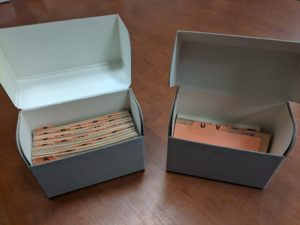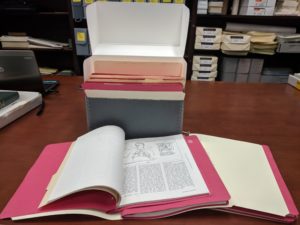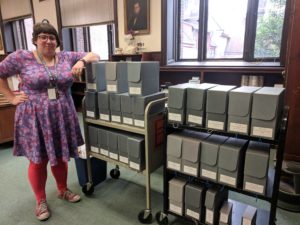– by Allie Shanafelter, Archives intern
Nearing the end of my time in the Information and Library Science program at Drexel University, I realized that I had been taught theory but did not have very much hands-on experience working in special collections or archives. So, I decided it was time to find an internship. I had heard about the Historical Medical Library during one of my courses at Drexel and was already familiar with the associated museum. I was very excited to begin my internship at the Historical Medical Library in mid-April. I was given the daunting task of processing the College of Physicians of Philadelphia’s continuing education records which date from the early 70s to the early 80s.
During this time period, continuing education was just becoming mandatory for physicians in the United States. Until that point, doctors and physicians could receive a lifetime certificate to practice medicine. State boards began to change requirements, and doctors risked losing their license if they did not complete a set amount of continuing medical education per year. These credits could be obtained by attendance at approved lectures, courses, symposiums, and other events. These records track the College of Physicians’ involvement in continuing medical education.
Because these credit hours were required by state law, it was essential to keep detailed records of attendance. A large portion of the records are detailed attendance records tracked on lists, information cards, and even entire files. Because these records were exhaustive, it could easily be confirmed when either a participant or an institution needed proof of a doctor’s continuing medical education credits. The Practice Related Education in Cardiovascular Disease for Physicians in Primary Care (PREP CV) program tracked their participants kept track of their participants on small cards filled out by hand.
Some of the more interesting aspect of these programs include early distance learning. Now, distance learning is simple. All you need is a computer and an internet connection to take courses at an institution across the country or around the world. In the 70s, this process was different. Participants in the distance education Practice Related Education for Physicians in Primary Care (PREP) course would receive materials by mail and then return them when they were done studying. These included VHS tapes, audio recordings, and books. In some cases, participants would be left waiting while someone else was using the materials. There was even correspondence from a doctor in Africa who was expecting these materials by airmail for months.
All of these records deal with various continuing education programs and were already roughly organized by their specific programs and topics, so I determined it would be best to preserve this method of organization and assign program names as series. There are a total of 10 series in this collection including Programs, Correspondence, Basic Science Section, Focus, College Night, Practice Related Education for Physicians in Primary Care, Practice Related Education in Cardiovascular Disease for Physicians in Primary Care, Continuing Medical Education, Emergency Medicine, and Other Programs.
Finally, after over a month of work and the realization and quick correction of a major mistake (although isn’t that the best way to learn), the collection is finally processed, described, and included in ArchivesSpace where it can be found by researchers. I am grateful for the chance to earn some practical experience and have learned a lot.
You can view the finding aid for the Records of Continuing Medical Education Programs here.



